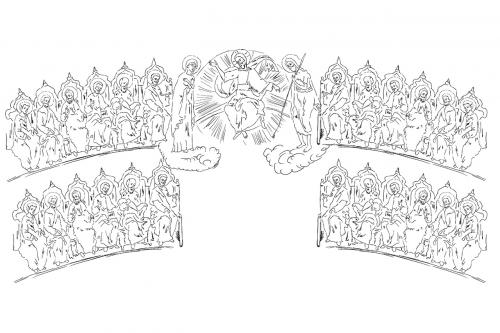



Christ in Majesty
It is an iconographical theme originally from the West, already known in post-Byzantine Italy of the 13th. Century, representing the Heavenly Throne surrounded by the angelic orders, prophets and saints.
The theme is based on the Book of Revelation (4:2-3, 4:4, 4:10-11, 5:9, 5:11). The identification of the enthroned character with Jesus , mentioning the 12 Apostles seated around Him, is based on the Gospel, namely Matthew (19:28). Two iconographical themes were developed from these textual sources: The Last Judgement and Christ in Majesty. Although each theme has a different significance, in both, saints and the angelic orders surround the celestial throne. A third source of the theme may be found in the votive portraits. From the very beginning, such portraits were present in Christian iconography, where the patron, accompanied by the intercessor saints, worshipped an enthroned person: the Virgin with Child or Jesus.
As an individual theme, Christ in Majesty does not belong to the Orthodox canon, being borrowed quite seldom and very late from the Western iconography. However, it is always included in the Last Judgement representations, where in the upper part of the composition the Heaven is depicted having in its centre the iconographic theme of Christ in Judgement. The enthroned Jesus is surrounded by all types of saints (apostles, martyrs, hermits, etc.) and the angelic orders. If in the Western art the composition is usually circular, in Byzantine art a multi-stripped composition is preferred, where every strip includes a group of saints, often enthroned as in the case of the Apostles. The background is frequently painted in a neuter color, usually gold in order to symbolize the heavenly timeless character of the theme.
It is an iconographical theme originally from the West, already known in post-Byzantine Italy of the 13th. Century, representing the Heavenly Throne surrounded by the angelic orders, prophets and saints.
The theme is based on the Book of Revelation (4:2-3, 4:4, 4:10-11, 5:9, 5:11). The identification of the enthroned character with Jesus , mentioning the 12 Apostles seated around Him, is based on the Gospel, namely Matthew (19:28). Two iconographical themes were developed from these textual sources: The Last Judgement and Christ in Majesty. Although each theme has a different significance, in both, saints and the angelic orders surround the celestial throne. A third source of the theme may be found in the votive portraits. From the very beginning, such portraits were present in Christian iconography, where the patron, accompanied by the intercessor saints, worshipped an enthroned person: the Virgin with Child or Jesus.
As an individual theme, Christ in Majesty does not belong to the Orthodox canon, being borrowed quite seldom and very late from the Western iconography. However, it is always included in the Last Judgement representations, where in the upper part of the composition the Heaven is depicted having in its centre the iconographic theme of Christ in Judgement. The enthroned Jesus is surrounded by all types of saints (apostles, martyrs, hermits, etc.) and the angelic orders. If in the Western art the composition is usually circular, in Byzantine art a multi-stripped composition is preferred, where every strip includes a group of saints, often enthroned as in the case of the Apostles. The background is frequently painted in a neuter color, usually gold in order to symbolize the heavenly timeless character of the theme.




